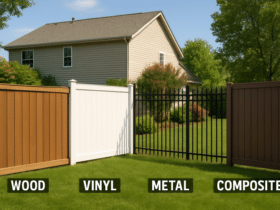Table of Contents
- Introduction to Backyard Transformation
- Planning: The Key to Success
- Choosing the Right Plants
- Integrating Water Features
- Eco-Friendly Landscaping Practices
- Enhancing Privacy with Greenery
- Seasonal Maintenance Tips
- Conclusion: Your Dream Backyard Awaits
Introduction to Backyard Transformation
Transforming your backyard into a lush oasis enhances aesthetic appeal and promotes sustainability. Embracing eco-friendly practices ensures a beautiful outdoor space and a healthier environment for you and your family. Whether on a tight budget or planning to enlist professional help, finding affordable landscaping services in Massachusetts can help you balance cost and creativity. This journey involves detailed planning, wise plant selection, and sustainable practices, each pivotal in achieving a vibrant garden space.
Creating your perfect outdoor retreat requires more than just planting a few flowers. From integrating water features to ensuring seasonal upkeep, various elements contribute to a successful backyard transformation. This article will guide you through the multifaceted process of creating a serene and sustainable outdoor living area.
Planning: The Key to Success
Embarking on a backyard transformation requires more than just enthusiasm—it demands a well-thought-out and strategic plan. Start by envisioning how you want the space to function. Will it be a quiet retreat, a play area for children, or an entertainment hub for gatherings? Consider the layout carefully, factoring in traffic flow, accessibility, and how different zones—like seating areas, gardens, and walkways—will coexist within the space.
Equally important is understanding the environmental context. Analyze your local climate, sun and shade patterns, and soil conditions to guide plant selection and material durability decisions. For instance, sun-drenched areas may call for drought-tolerant plants or shaded seating to ensure comfort. Incorporating natural landscape features like slopes or existing trees can enhance the aesthetic while reducing the need for extensive grading or removal.
When in doubt, seeking professional help can make a significant difference. A landscape designer brings experience in creating harmonious and practical outdoor spaces, and their guidance can help avoid expensive missteps. Organizations such as the American Society of Landscape Architects (ASLA) provide directories to help homeowners find accredited experts. These professionals can transform your ideas into sustainable and visually appealing designs tailored to your needs.
Choosing the Right Plants
Plant selection forms the backbone of any sustainable garden design. Native plants require less water and maintenance, effectively supporting the local ecosystem by providing habitat and food to native wildlife. For instance, incorporating a variety of flowering plants can attract beneficial pollinators such as bees and butterflies. The National Wildlife Federation offers comprehensive guidelines on selecting the best native plants, contributing to overall garden vitality and ecological balance.
Integrating Water Features
Water features like ponds, waterfalls, or fountains introduce a soothing element to your garden, enhancing its aesthetic and environmental appeal. Water features such as ponds, fountains, and small streams are crucial in improving garden ecosystems. These installations provide essential habitats for aquatic plants and animals, encouraging biodiversity. Frogs, dragonflies, and other wildlife often thrive in such environments, contributing to a balanced and vibrant garden ecology.
To ensure environmental responsibility, it’s vital to prioritize water sustainability when incorporating these features. Utilizing recirculation systems helps minimize water waste by continuously cycling the same water. Integrating rainwater harvesting technologies can also supply natural water sources, reduce reliance on municipal systems, and promote eco-friendly garden management.
Beyond their ecological and practical benefits, water elements can significantly elevate a garden’s visual and sensory appeal. When strategically placed, they create a tranquil ambiance, offering soothing sounds and reflective surfaces. These features can also act as stunning focal points, harmonizing with the overall landscape design and enhancing the garden’s aesthetic charm.
Eco-Friendly Landscaping Practices
Sustainable landscaping goes beyond aesthetics—creating a thriving garden that supports local ecosystems and minimizes harmful impacts. Choosing native plants is a great starting point. These species are adapted to your region’s climate and soil, requiring less water, fertilizer, and maintenance than non-native varieties. They also support pollinators like bees and butterflies, which are crucial for biodiversity. Integrating native plants into your design reduces your environmental footprint and ensures your garden is naturally resilient and beautiful.
Water conservation is another vital component of eco-friendly landscaping. Installing efficient irrigation systems, such as drip irrigation or soaker hoses, helps deliver water directly to plant roots, reducing evaporation and runoff. Grouping plants with similar water needs together can further optimize water usage. Additionally, using rain barrels to collect water for irrigation can reduce municipal water use, making your garden even more sustainable.
To enhance soil health naturally, turn to composting and mulching. Composting kitchen scraps, yard clippings, and organic matter enriches the soil with nutrients, reduces landfill waste, and eliminates reliance on synthetic fertilizers. Organic mulch helps retain moisture, suppress weeds, and regulate soil temperature. Over time, mulch breaks down and contributes to soil fertility, creating a closed-loop system that keeps your garden healthy and thriving without harming the environment.
Enhancing Privacy with Greenery
Creating a sense of privacy in your backyard doesn’t have to involve harsh fences or unsightly walls. Instead, use plants to craft a natural barrier that feels lush and inviting. Fast-growing shrubs like privet, laurel, or arborvitae can be planted closely together to form living fences. These hedges offer year-round screening, dampen street noise, and can be shaped to match the aesthetics of your yard, making them both functional and visually pleasing.
For smaller spaces or areas where traditional hedges may not work, vertical greenery provides an elegant solution. Installing trellises or pergolas adorned with climbing plants such as wisteria, clematis, or jasmine adds privacy and charm. These flowering vines create dynamic seasonal displays while offering a gentle screen from neighbors. They’re handy for balconies or patios where space is limited, but intimacy is still desired.
You can also strategically position trees and tall ornamental grasses to define private zones in your outdoor space. Trees like birch or maple provide dappled shade and visual separation, while tall grasses like pampas or feather reed grass create soft, swaying walls. Combined with seating areas or water features, this layered approach transforms your yard into a peaceful sanctuary that feels secluded and serene without sacrificing style or openness.
Seasonal Maintenance Tips
Caring for your backyard throughout the year ensures it remains healthy, functional, and beautiful every season. Spring is a crucial time for rejuvenation—pruning dead or overgrown branches encourages new growth and maintains shape. It’s also the best time to plant annuals and fertilize garden beds to jump-start the growing season. Clearing out debris left over from winter helps prevent disease and pest infestations as your garden wakes up.
In the summer, you should focus on maintaining hydration and protecting plants from heat stress. Regular watering—ideally in the early morning or late evening—keeps moisture levels steady. Mulching during the hotter months is essential to prevent soil from drying out and suppress weeds. Summer is also when pests are most active, so it’s wise to monitor plants for signs of trouble and address issues promptly with eco-friendly solutions like neem oil or insecticidal soap.
As autumn approaches, it’s time to prepare the garden for dormancy. Rake fallen leaves into compost, plant hardy bulbs for spring blooms, and cut back perennials after their final flowering. Before winter sets in, wrap sensitive plants or move them indoors to protect them from frost. Applying a fresh layer of mulch insulates the soil and roots from temperature fluctuations. These seasonal steps keep your backyard vibrant and healthy year-round, ensuring it remains a reliable retreat no matter the weather.
Conclusion: Your Dream Backyard Awaits
You can create a backyard that reflects your values and style by embracing thoughtful design and sustainable practices. Each element contributes to crafting a harmonious outdoor space, from eco-conscious landscaping to intentional plant placement for privacy. This kind of planning enhances the beauty of your environment and makes your maintenance routine more efficient and enjoyable.
Your outdoor oasis doesn’t need to be elaborate to be impactful. Whether you’re cultivating a peaceful reading nook under a tree, a lively garden full of pollinators, or a place to gather with friends and family, every detail contributes to your overall experience. The satisfaction of creating a space that’s both inviting and environmentally responsible is well worth the effort.
Ultimately, a well-designed backyard is more than just a recreational area—it becomes a personal haven. With consistent care, seasonal attention, and an eye toward sustainability, your garden will thrive and evolve with you over time. So start envisioning, planning, and planting—your dream backyard is just a few steps away.












